We propose a pilot project to investigate the effects of artificial rearing on cisco DNA methylation. This project will build on an ongoing project funded in FY24 led by A. Honsey (“Effects of incubation temperature on survival, growth, morphology, and gene expression...
morphology
Expanding efforts to document and understand Great Lakes coregonine river spawning – Year 2
Restoration and conservation efforts hinge on the identification of key habitats, such as fish spawning habitats (Lewis et al. 1996; Kondolf 2000), and the potentially distinct populations that use them. Knowledge of these habitats can help to ensure that conservation...
Effects of incubation temperature on survival, growth, morphology, and gene expression of artificially reared cisco (Coregonus artedi): implications for best practices for captive propagation and restoration
A key tool for Great Lakes coregonine restoration is reintroduction via fish stocking. Stocking programs are currently underway, including efforts to restore cisco Coregonus artedi in Saginaw Bay, Lake Huron (Lake Huron Technical Committee 2007; Riley and Ebener 2020)...
Examining the potential for unrepresentative sampling during cisco Coregonus artedi gamete collections for the Saginaw Bay restoration effort
Great Lakes cisco populations declined during the 19th and 20th centuries due to factors such as overfishing, habitat degradation, and interactions with invasive species (Van Oosten 1930; Crowder 1980; Myers et al. 2009; George 2019). Cisco are now considered...
Examining the potential for unrepresentative sampling during cisco Coregonus artedi gamete collections for the Saginaw Bay restoration effort – Year 2
The cisco Coregonus artedi restoration effort in Saginaw Bay utilizes gametes sourced from northern Lake Huron, in the Les Cheneaux Islands and Drummond Island region (LHTC 2007). Gametes have been collected from bays in the Les Cheneaux area and Whitney Bay (Drummond...
Morphological and genomic assessment of putative hybridization among deepwater ciscoes and between deepwater ciscoes and typical artedi in Lakes Michigan and Huron
Species diversity can be lost through a combination of demographic decline and hybridization (Mallet 2005; Seehausen 2006). Regarding diversity losses among Ciscoes (subgenus Leucichthys, genus Coregonus) across the Great Lakes, the demographic decline in the 20th...
Resolving taxonomy of the cisco (Coregonus) species complex in the Laurentian Great Lakes and Lake Nipigon
The manager endorsed Coregonine Restoration Framework (CRF) identified a need for reviewing and updating the taxonomy of ciscoes, and this task was assigned to the first of four science teams established in the Planning Phase of the CRF. The ‘Resolve cisco taxonomy’...
Morphological and genomic assessment of putative hybridization among deepwater ciscoes and between deepwater ciscoes and typical artedi in Lakes Michigan and Huron – Year 2
Although species diversity can be lost through hybridization (Mallet 2005; Seehausen 2006) and hybridization has been common among ciscoes (genus Coregonus, subgenus Leucichthys; Smith 1964; Todd and Stedman 1989; Eshenroder et al. 2016; Ackiss et al. 2020), the...
Resolving the cisco complex of Lake Superior using morphological and genetic tools
Here we seek additional funding to follow-up a previous GLRI-funded project, “Morphologic, geographic and genetic variation among Lake Superior ciscoes.” Our goal was to conduct a comprehensive description of the morphological and genetic diversity of the Lake...
How does ecological function correspond to morphology in Great Lakes coregonines?
Human activities have caused widespread biodiversity loss, particularly in freshwater systems. For example, historical fish assemblages of the deepwater habitats of the Laurentian Great Lakes were dominated by up to eight closely related taxa from the genus Coregonus....
Morphologic, geographic and genetic variation among Lake Superior ciscoes
The Laurentian Great Lakes once contained a diverse endemic cisco complex, but a series of factors resulted in declines in diversity and now Lake Superior is the only Great Lake with a relatively intact cisco complex. Although the large, pelagic cisco, Coregonus...
